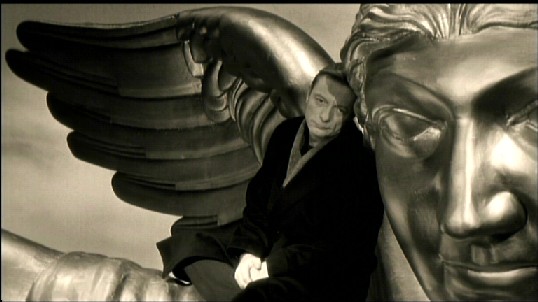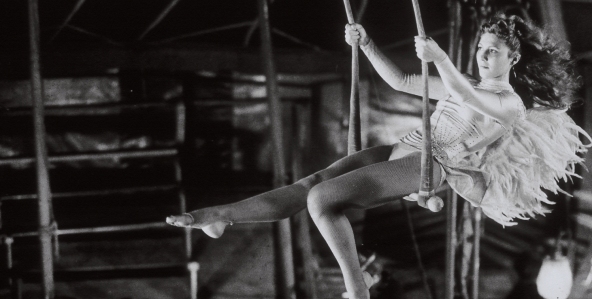“I now know what no angel knows: a sense of amazement.”
The blissful reverie of a movie that is Wim Wenders’s “Wings of Desire” reveals that sense of amazement, wonder and internal gazing that all humans need to live life fully. It’s a movie full of its muchness, its ideas and its people, but it often feels as confusing, mysterious and lyrical as life itself.
It tells the story of an angel, Damiel (Bruno Ganz) who has looked over Berlin for eternity but desires to “take the plunge” into human existence. “I’ve stood outside the world long enough,” he says. He desires the ability to live in the present, not in eternity, to know the feeling of a weight on his shoulders and be able to smell, taste and touch things for himself. He’s inspired by the sight of a beautiful trapeze artist (Solveig Dommartin), twirling in midair as an angel on Earth.
His desires are not presented literally. They’re filtered through the thoughts and emotions of the people both he and his partner Cassiel (Otto Sander) observe. “How is it that this me wasn’t here before I was me, and that there won’t be a me after this me is gone?” It’s as if these spirits don’t know the meaning of their existence either. Their purpose is to “look, gather, testify and preserve.” Through their black and white eyes, even the mundane of the human world have a poetic, spiritual beauty.
One man wonders why his son has no other interests than music, realizing that buying him a guitar didn’t do enough to please him. Another elderly man struggles to climb up stairs in a library and later wanders the streets reflecting on his time in the war. A teenager’s mind races with thoughts that he needs to leave this life but knows not why as he leaps off a building to his death.
Wenders directs this all with intimate grace and beauty. The camerawork by legendary cinematographer Henri Alekan (Cocteau’s “Beauty and the Beast”) grants us an immediate, spiritual perspective, gliding elegantly through such small places as a library in tracking shots and in arching crane shots that seem to give us a glimpse of the world as a whole. The humans cannot see Damiel and Cassiel, but occasionally Wenders has them look toward the camera and force us to acknowledge our own presence, to ask our own questions as they ask theirs. Their lilting, whispered voices inside their head may not even mean anything specific to us, but as we’re inside their mind for that brief moment we know just how much it means to them.
Shooting in black and white from the angel’s perspective and in color from the human perspective, “Wings of Desire” owes some credit to “A Matter of Life and Death,” an Old Hollywood romantic comedy that shows heaven in black and white, Earth in color and also knows the joys of living and feeling. In this way, both films are deeply spiritual, and “Wings of Desire” very sanctimonious, but they are hardly “religious.” Characters do not pray, they do not mention God or Christianity. They do not even ask the precise purpose of life but wonder what it is to really live. It’s even more interested in what it reflects of West Germany at the time, a city divided and isolated by the Cold War and left with their own questions and ideas.
But the part I like best in “Wings of Desire” is when it stops being the German art house film for a moment. Damiel wakes up in an empty lot in color and notices three kids staring at him. They assume he’s drunk as they run and giggle away. He gets up and his first sight is a magnificent graffiti mural on a long horseshoe wall. The scene is perfect, but Damiel asks something of the artist that makes it real; he asks what they call each color, and once yellow, blue and green are all named, they never looked so vibrant.
It’s also memorable for Peter Falk playing himself during an on-location shoot in Berlin. He has a scene where he tries on different hats that really doesn’t fit the movie’s flow, but it’s funny and genuine and gets us inside his head without giving him an internal monologue. We realize that he’s aware of the angels’ presence although he cannot see them, and he explains the joys of simply rubbing your hands together when its cold. His line to the newly awakened Damiel is again not as poetic as the rest of the film, but it feels right. “You have to find out yourself. That’s the fun of it.”
Suddenly this arty, metaphorical movie has become something else: a direct, colorful, accessible movie in the German New Wave. It takes us to a brooding, underground post-punk show and puts us in a new kind of trance. Its ending perhaps jams too much philosophy into one lovelorn conversation, but it casts us in the moment that is both now and never.
Wim Wenders directed “Wings of Desire” after the film that won him the Palme D’Or at Cannes, “Paris, Texas,” a loose remake of “The Searchers” with Harry Dean Stanton. Wenders did however win Best Director at the 1987 Cannes and made a sequel to this film called “Faraway, So Close!” He’s been nominated for two Oscars, but both for documentaries. He’s an ambitious, profound director. His films are timeless and spiritual, but they operate in the here and now.


